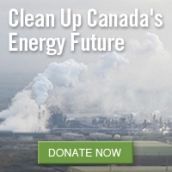Water Use
Oil sands operations return almost none of the water they use to the natural cycle.1
- Oil sands mining operations are subject to a zero-discharge policy because of the toxins in the waste water. Waste water that is not recycled is stored in tailings lakes.2
- Waste water from in-situ processes is often re-injected deep underground.3
Mining operations alone are licensed to divert 652 million cubic metres of water each year, about seven times as much as the annual water needs of the Edmonton area.4
- Mining requires between two and four barrels of water to extract and upgrade one barrel of bitumen.5
- In-situ techniques require between 0.6 and 0.9 barrels of water to extract6 and upgrade7 one barrel of bitumen.
- These volumes are in addition to the water which is recycled through the processes.
Current water withdrawals risk affecting ecosystem of the Athabasca River, which flows into one of the world’s largest freshwater deltas.
- The majority of the water used for mining is taken from the Athabasca River.8
- According to the awarded water licenses, current and proposed projects could withdraw more than 15% of the Athabasca River’s water flow during its lowest flow periods.9
- Water withdrawals during winter low-flow periods risk reducing the availability of fish habitat and could reduce the health of the river’s ecosystem.10
- 1. Mary Griffiths, Amy Taylor and Dan Woynillowicz, Troubled Waters, Troubling Trends: Technology and Policy Options to Reduce Water Use in Oil and Oil Sands Development in Alberta (Drayton Valley, AB: The Pembina Institute, 2006), 85.
- 2. Mary Griffiths, Amy Taylor and Dan Woynillowicz, Troubled Waters, Troubling Trends: Technology and Policy Options to Reduce Water Use in Oil and Oil Sands Development in Alberta (Drayton Valley, AB: The Pembina Institute, 2006), 33.
- 3. Mary Griffiths, Amy Taylor and Dan Woynillowicz, Troubled Waters, Troubling Trends: Technology and Policy Options to Reduce Water Use in Oil and Oil Sands Development in Alberta (Drayton Valley, AB: The Pembina Institute, 2006), 89.
- 4. Oil sands mining water allocations are from Alberta Environment, “Water Diversion by Oilsands Mining Projects in 2008” (data received March 2010). EPCOR Water Services reported treating 92.9 million cubic metres of water for the greater Edmonton area in 2008 (2008 Performance Based Regulation Progress Report [2009], 8).
- 5. In 2004, the Albian Sands, Suncor and Syncrude mining operations used on average 2.62 cubic metres of water to produce one cubic metre of bitumen. When the upgrading of bitumen to synthetic crude oil is included, the overall average is 4.04 cubic metres of water (Alberta Energy Utilities Board, personal communication, February 8, 2006). Suncor reported using 2.29 cubic metres of water per cubic metre of synthetic crude oil in 2008 (Suncor Energy Ltd., A Closer Look: An Update on Our Progress, 4.) Note that Suncor’s operations include in situ projects, which use less water per unit of bitumen produced than do mining operations, so Suncor’s average water use for mining operations may exceed 2.29 cubic metres of water per cubic metre of synthetic crude oil. Syncrude reported using 2.26 cubic metres of water per cubic metre of synthetic crude oil in 2008 (Syncrude Canada Ltd., 2007 Sustainability Report). See also R. J. Mikula ,V. A. Munoz and O. Omotoso, “Water Use in Bitumen Production: Tailings Management in Surface Mined Oil Sands,” presented at the World Heavy Oil Congress, Edmonton, 2008, 1.
- 6. Mary Griffiths, Amy Taylor and Dan Woynillowicz, Troubled Waters, Troubling Trends: Technology and Policy Options to Reduce Water Use in Oil and Oil Sands Development in Alberta (Drayton Valley, AB: The Pembina Institute, 2006).
- 7. Randy Provencal, Shell Canada Limited, personal communication, March 2006. In 2005 Shell diverted 6,254,580 cubic metres of water for the Scotford upgrader (75% of the licence limits) to produce 3,447,500 cubic metres (56,575,000 barrels) of oil. See also, Scotford Upgrader Project Application, 1998, Vol. 1, pages i and 4-1, for initial project design figures.
- 8. Alberta Environment, “Water Diversion by Oilsands Mining Projects in 2007,” data received September 2008.
- 9. Imperial Oil Limited, Imperial Kearl Oil Sands Mine Application (no. 1408771 & 1414891, volume 4), (Calgary, AB: Imperial Oil Ltd., 2005), 3-31.
- 10. Mary Griffiths, Amy Taylor and Dan Woynillowicz, Troubled Waters, Troubling Trends: Technology and Policy Options to Reduce Water Use in Oil and Oil Sands Development in Alberta (Drayton Valley, AB: The Pembina Institute, 2006), 69.



